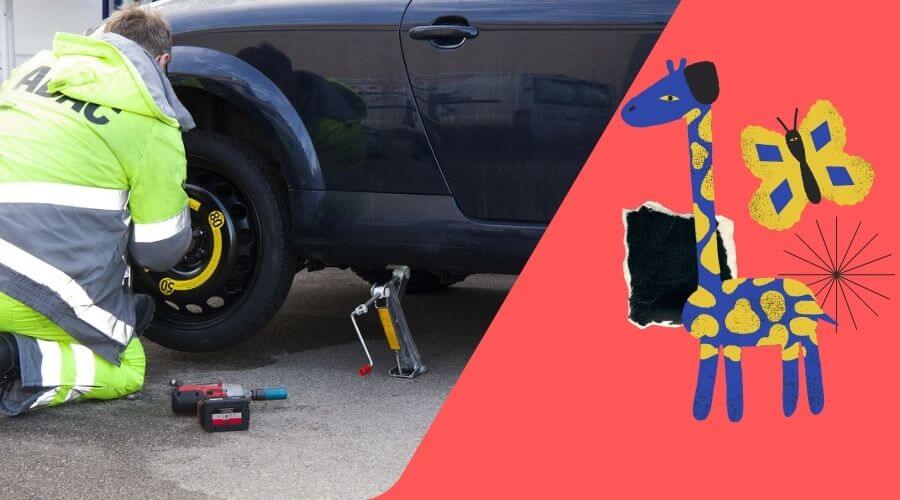Last Updated on July 31, 2021 by Mark S. Taylor
Undoubtedly, tires are one of the most important parts of a car. Without tires, the car cannot move. However, like other parts of a car, they are subject to wear and tear and are not permanent. One of the most common tire wear problems is cracking. Also called dry rot, as the name suggests, small cracks begin to appear on the tires. safely. If you are not ready to buy new tires, you can have your damaged tires repaired. This section describes how to do this and describes possible root causes.
Contents
Common causes of Cracked Tires
Before understanding how to repair a cracked tire, it is advisable to first understand its cause. This will primarily help prevent dry rot. This is the most common cause of ligament fractures.
High humidity and high temperature
High humidity and extreme temperatures are the main reasons for the appearance of tires. High humidity causes the rubber to loosen quickly and crack frequently. In terms of temperature, the hot sun destroys various rubber compounds, giving them strength. Even at subzero temperatures, rubber dries and hardens, so it cracks easily.
Long-term failure
Prolonged use can cause engine damage, rust, and dry rot of metal parts. Tires contain several beneficial compounds that help you stay healthy, such as antioxidants and oils. And ensure a long life. If you park in one place for a long time, the lumps will fall to the ground and evaporate, which will not prevent the tires from bursting.
Overpressure Tire
Tire Vacuum or Vacuum Overpressure or vacuum often causes problems, and one of them is dry rot, so always check the pressure in your car. This is because the wider surface between the road and the road provides more contact with the road and generates more heat, causing cracking. For street tires, additional pressure is added to the sidewall of the tire, causing the tire to expand and eventually crack and burst.
Requirements for the quality of materials
When you first buy tires made from substandard materials, they are prone to common problems like dry rot. Poor quality rubber and poor-quality tire material may not support the tire. In addition, it is more susceptible to heat and cold, making it more sensitive than high-quality rubber.
Ordinary Elastic Aging
Even buying the highest quality tires will last longer, like an aging natural rubber car. Tires often develop small cracks over time due to normal wear and tear. When tires are subjected to various stresses for thousands of kilometers over many years, the rubber can eventually weaken, and cracking is one of the most important signs of this.

The methods of Fixing cracked Tires
The first thing to do before replacing a cracked tire is to try and get it repaired. This can save you a lot of money. And it’s easier than you think because all you need is some free time.
Method 1: Sticking Cracks Inside with a Sealant
The first method is like patching a flat tire and is best for small, hard-to-reach cracks. And the most important thing about this method is to make sure you are using a dry, rotten, cracked sealant that is appropriate for the type of tire you are using.
Step 1: Cooling the vehicle, it is always important to cool the tires before working on the tires. When the tires meet the road surface, they heat up due to friction, and it is dangerous to work in hot conditions.
STEP 2: REMOVING THE TIRE The next step after the tire has cooled down is not to remove the tire. It can effectively seal when left in the car. Dry rot often affects tires inside and out, so it is important to lift the vehicle and remove the tires. You can check this only by removing the tire.
Step 3: Checking Tires Next, you need to check your tires thoroughly. Determine the extent of the damage and make an appropriate resolution plan. More attention is required as tires can be inspected to identify the most affected areas. It is also a step to check if the tires are in bad condition.
Step 4: Prepare and apply sealant. Now that you know the location and size of the crack, it’s time to apply the sealant. If the type you are using requires preparation such as mixing, once the sealant is ready, apply it to the inside of the tire according to the instructions provided. Most types have a nozzle or injector that fits into the valve stem.
Step 5: Re-inflate the tire, inflate it again and use a pressure gauge to check the correct pressure. Tension is important because air can be lost when handling tires.
Step 6: Fitting and Driving Tires The last step is to reinstall the tires so that you can drive the car. It is important to look around as the sealant will flow through the tire and seal the crack. However, some sealants can effectively seal cracks without triggering.
Method 2: Sticking Cracks Outside with a Protectant
For larger and more visible cracks, an outer seal with protection is more suitable. This method is also suitable if you want to regenerate the rubber of the tire and protect it from UV rays.
Procedure
Step 1: Let the vehicle cool down. Allow the vehicle to cool down before starting work or do not heat it up to the point where you can touch it.
Step 2: Raise the car and remove the broken tire. Like the compaction method described above, it may not work as efficiently if the tires are mounted on the vehicle. After removing the tires from the vehicle, carefully inspect the tires and measure for cracks.
Step 3: After determining the extent of the crack that expands the tire surface, the next step is to start working on the tire. The first thing you need to do to apply a degreaser: Each degreaser has a specific application process, but in most cases, you will need to apply a small amount to a sponge and then apply enough to the tire. It should cover the entire surface. When degreasing, be sure to wipe the edges to accentuate the cracks.
Step 4: Wash the box thoroughly and rinse it as the next step to clean the leather surface. After leaving the degreaser on the field for a while, the field is covered with a neat carpet. After cleaning, the next step is to attach the hose to the field and check that it is in the correct position. Then let it dry for a while.
Step 5: Install the protective cover. When the tires are completely dry, you can proceed to the most important stage of installing the protective casing. Tire protection products must be sprayed or applied. The protection of tires on the surface of tires depends on the type. Here you need to make sure that it covers the entire surface and not just cracks. Most visors take a long time to repair, so you’ll have to stand for hours to fix your tires. Tire retreading at the last stage after the tires have hardened.
Follow Tips avoid cracked Tires
Cracked tires can be repaired, but they no longer look like new. Therefore, it is necessary to ensure that the tires do not crack first. Here are some helpful tips.
- Keep your tires in good condition by regularly cleaning and servicing them.
- Cover your car when it is parked or parked in the garage.
- Do not leave the car in one place for a long time.
- Avoid cheap and low-quality rubber tires.
- Never drive a car with tires that are too low or too low.
- Put on the protective cover at least once a month.
- Remember to check your tires regularly.
Inference
As car tires age, rubber weakens and loses strength, and dry rot and cracking are inevitable. The good news is that there is an easy way to fix this problem. In this simple repair, the tires are sealed with a sealant on the inside and a protective gasket on the outside. However, it is important to remember that tires are not technically repaired, they will only slow down cracking. Or the dry rot method. Therefore, it is best to follow the tips above to prevent dry rot.
Read More: The Best Tire Gauge For Car
FAQ
Can you fix a broken tire?
To do this, tears must be washed off with an antifouling spray (carbohydrate cleaners are also effective). Rub in tears to soften them. This will help the glue stick to each other. When the gap is dry and clean, press down on the elastic adhesive to secure the tire.
Is it dangerous to drive with broken tires?
If the sidewalk is small and level, it may be safer to ride with more tires. … these cracks can quickly wear out tires, and once the number of visible cracks is small, several large cracks will appear, putting the tire at risk of sidewall rupture.
How to save a cracked tire?
Do not expose tires to direct sunlight, or leave them dry or wet for a long time. When storing tires, keep windows and garages away from direct sunlight and keep them indoors if possible.
How long can you drive with dry and rotten tires?
All you must do is drive a car with dry and rotten tires to a car repair shop or tire service. As the tire rots and dries, it is easier for air to escape from the crack in the rubber tire.

